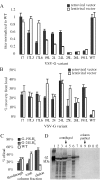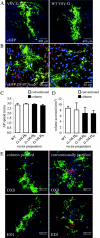Selection of novel vesicular stomatitis virus glycoprotein variants from a peptide insertion library for enhanced purification of retroviral and lentiviral vectors
- PMID: 16537595
- PMCID: PMC1440395
- DOI: 10.1128/JVI.80.7.3285-3292.2006
Selection of novel vesicular stomatitis virus glycoprotein variants from a peptide insertion library for enhanced purification of retroviral and lentiviral vectors
Abstract
The introduction of new features or functions that are not present in an original protein is a significant challenge in protein engineering. For example, modifications to vesicular stomatitis virus glycoprotein (VSV-G), which is commonly used to pseudotype retroviral and lentiviral vectors for gene delivery, have been hindered by a lack of structural knowledge of the protein. We have developed a transposon-based approach that randomly incorporates designed polypeptides throughout a protein to generate saturated insertion libraries and a subsequent high-throughput selection process in mammalian cells that enables the identification of optimal insertion sites for a novel designed functionality. This method was applied to VSV-G in order to construct a comprehensive library of mutants whose combined members have a His6 tag inserted at likely every site in the original protein sequence. Selecting the library via iterative retroviral infections of mammalian cells led to the identification of several VSV-G-His6 variants that were able to package high-titer viral vectors and could be purified by Ni-nitrilotriacetic acid affinity chromatography. Column purification of vectors reduced protein and DNA impurities more than 5,000-fold and 14,000-fold, respectively, from the viral supernatant. This substantially improved purity elicited a weaker immune response in the brain, without altering the infectivity or tropism from wild-type VSV-G-pseudotyped vectors. This work applies a powerful new tool for protein engineering to construct novel viral envelope variants that can greatly improve the safety and use of retroviral and lentiviral vectors for clinical gene therapy. Furthermore, this approach of library generation and selection can readily be extended to other challenges in protein engineering.
Figures






References
-
- Baekelandt, V., A. Claeys, K. Eggermont, E. Lauwers, B. De Strooper, B. Nuttin, and Z. Debyser. 2002. Characterization of lentiviral vector-mediated gene transfer in adult mouse brain. Hum. Gene Ther. 13:841-853. - PubMed
-
- Baekelandt, V., K. Eggermont, M. Michiels, B. Nuttin, and Z. Debyser. 2003. Optimized lentiviral vector production and purification procedure prevents immune response after transduction of mouse brain. Gene Ther. 10:1933-1940. - PubMed
-
- Boder, E. T., and K. D. Wittrup. 1997. Yeast surface display for screening combinatorial polypeptide libraries. Nat. Biotechnol. 15:553-557. - PubMed
-
- Brune, W., C. Menard, U. Hobom, S. Odenbreit, M. Messerle, and U. H. Koszinowski. 1999. Rapid identification of essential and nonessential herpesvirus genes by direct transposon mutagenesis. Nat. Biotechnol. 17:360-364. - PubMed
Publication types
MeSH terms
Substances
Grants and funding
LinkOut - more resources
Full Text Sources
Other Literature Sources

